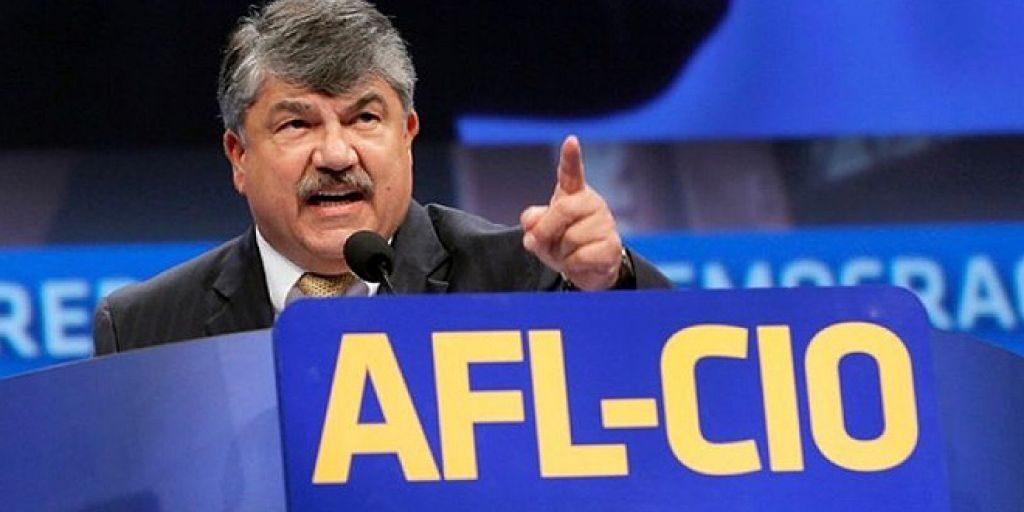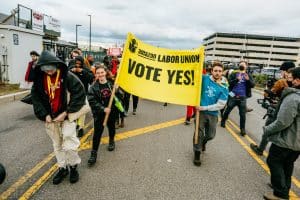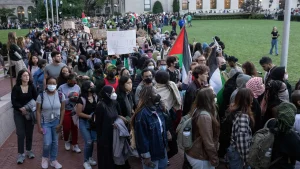On March 9, the U.S. House of Representatives narrowly passed the Protecting the Right to Organize Act (PRO Act), by a vote of 225 to 206. Widely supported by organized labor, the legislation was one of the cornerstones of Biden’s promises to unions on the campaign trail, and will now move on to the Senate where it faces stiff opposition. If passed by the Senate, the PRO Act would be a victory for labor unions and could possibly help reverse the decades-long decline in union density since the 1970s. Unfortunately, the bill stands little chance of passing in its current form. In fact, without a strong movement behind it, it is highly unlikely that it will pass in any form anytime before the 2022 elections. This is unfortunate, because many of the provisions in the PRO Act, particularly the sections that prohibit employers from interfering in union elections, could make it easier to organize at places like Amazon and Walmart, flashpoints in the struggle to build new unions, where union busting tactics are legion.
As a consequence of the progressive measures included in the act, many on the Left have uncritically praised the PRO Act, claiming rather hyperbolically that it is the most ambitious labor reform bill in generations. But this is simply not the case. The PRO Act would certainly make meaningful changes to the National Labor Relations Act (NLRA), but not all of those changes are only in the interests of unions. Further, such laws always come with a price, one the labor bureaucracy seems more than willing to pay. The closer unions are to the state and the more they are tamed and pacified by legislation, the more they lose their ability to be fighting organizations for the whole class, becoming mere service providers for their members. While there are many reasons for the long decline of labor density and militancy in the United States over the last sixty years, laws like the NLRA and the Taft Hartley Act that followed it are an integral part of that story. For instance, the NLRA, which was passed by FDR in 1935, guaranteed certain rights for unions, but it also helped to dramatically strengthen their bureaucratic leaderships, which have since become increasingly tied to the interests of big business and the Democratic Party.
How the Left responds in this situation is crucial. While we should most definitely support and even fight for the passage of the PRO Act in order to help build new unions, we must avoid the temptation to accept a few small crumbs for a broader peace, and recognize that such laws are never ultimately in our long term interests. If we want to win real gains we must prioritize building militant fighting unions, unconstrained by the limits imposed upon them by the state.
The NLRA and The Long Decline of Labor
Although often treated as a stand-alone piece of legislation by its supporters, the PRO Act is really little more than a series of amendments to the longstanding National Labor Relations Act (aka the Wagner Act), which was created in 1935. That bill, as many historians have pointed out, was a direct response to the massive labor uprisings of the early thirties, and, depending on who you ask, was either a huge concession given to labor by the government, a co-optation and pacification of the labor movement, or both. Indeed, in 1934, just one year before the passage of the Wagner Act, the United States was rocked by not one, but three massive strikes, all of which were led, in part, by radical socialists of one variety or another. The Minneapolis Teamsters strike, which lasted throughout the summer of 1934, the Auto-Lite Strike in Toledo that brought thousands of union members into fierce conflict with the national guard, and the West Coast Longshoremen Strike all posed serious challenges to the continued hegemony of capitalism. Afraid of the radically disruptive nature of such organized actions of the working class, proponents of the NLRA, including FDR, recognized that labor peace and commercial stability could only be achieved by establishing clear but limited guidelines for the establishment of unions and the process of collective bargaining.
You might be interested in: What is the Role of Socialists in the Unions
Passed the very next year, The NLRA created laws to defend the right to form unions, the right to collectively bargain with employers, and, to some extent, the right to strike within certain limited circumstances. This forced employers to recognize unions and to negotiate with them, and made unionization efforts easier. Following the passage of the NLRA the number of legally recognized unions increased dramatically. However, while the act was a concession to labor unions, its inevitable impact, especially after the passage of the Taft- Hartley Act in 1947, was the creation of a legalistic framework that brought labor and labor unions into the fold of the maintenance of capitalist production. No longer on the outside, labor found itself in the strange position of alternately being in conflict with and in alliance with the interests of U.S. capital. Just as bad, the passage of the Wagner Act by FDR (whom many still fallaciously revere as a champion of working people) was the beginning of what Mike Davis called the “barren marriage of Labor and the Democratic Party.” Because the continued existence of unions had been made into a largely legislative issue, union nationals and their bureaucratic leaderships began to pour untold amounts of energy, money, and ideological efforts into lobbying and supporting imperialist Democratic Party politicians to maintain and increase legal rights for unions. While this is hardly the only reason for the slow downfall of labor after the war, it was certainly a contributing factor to its declining militancy, particularly in the aftermath of the Vietnam War.
What’s Actually in the PRO Act
Like the NLRA, the PRO Act would provide increased protections for unions, but it would also further strengthen the bonds between organized labor and the state. Importantly, the PRO Act would make changes to the NLRA that would make unionization efforts easier. At a time of historically low union density this is nothing to sneeze at. Perhaps the most powerful change in this regard involves a redefinition of the difference between a contractor and an employee for the purposes of union organization and collective bargaining. For decades, employers have gotten around the threat of unionization by claiming that the workers who make the vast majority of profits for such companies are actually not workers at all, but independent contractors. Uber, Lyft, and DoorDash are but a few of the most egregious examples of this abuse of contractor status. By requiring three strict criteria for what defines an “independent contractor,” including, importantly, whether or not the “the service is performed outside the usual course of the business of the employer,” the PRO Act would make it harder, though hardly impossible, for companies like Uber to continue to treat its workers as independent contractors. While this could open the door to further unionization efforts at these companies, the law does nothing to change the designation with regards to unemployment insurance, workers’ compensation, overtime rules, etc. Additionally, the act would make illegal certain intimidation tactics, such as forcing employees to attend anti-union meetings, and would dramatically decrease the time between a unionization petition and a union vote. However, the law does not make non-mandatory anti-union meetings illegal, a door left wide open for intimidation and abuse by employers like Amazon.
In addition to making unionization easier, the PRO act also provides other important protections for unions. The most significant of these changes includes language that could limit one of the worst aspects of right to work legislation by allowing employees to bargain for what are known as “fair share agreements.” These agreements would require all employees represented by a union to pay dues whether they are union members or not. This is an important change, but it is not automatic. Winning such agreements would not be guaranteed, would be costly to unions, and could require real contractual concessions. For instance, it is quite possible that employers and labor bureaucrats in right to work states would pressure bargaining committees to accept no strike clauses in exchange for such “fair share agreements.” More ambiguous are the provisions in the PRO Act that allow forced arbitration by either party for first contracts. On first glance this sounds like it could be a powerful tool to require employers to bargain for a fair first contract, but this provision could and would just as easily be used by the employer to squash any attempts to win an ambitious first contract. First contracts often attempt to make up for decades of exploitation and mistreatment, but arbitration tends to find a happy medium between the parties involved relevant to prevailing wages and benefits in the industry. Forced arbitration would effectively cut out the option to strike to win a first contract, effectively tying the hands of the union to the bargaining table.
You might be interested in: Get Militant or Die: Labor Unions in the Age of Crisis
But the worst part of the PRO Act is what is missing from it. As Left Voice has argued before, the provisions for making unionization easier in the PRO Act are actually far less ambitious than previous proposed legislation, particularly the Employee Free Choice Act (EFCA), which, like the PRO Act, was promised and never delivered upon the last time Democrats controlled both houses of Congress and the executive in 2009. The EFCA, an unambiguously pro-union piece of legislation, would have made legally binding the organizing practice known as card check, which requires simply getting a majority of workers at a given workplace to sign a union card. The absence of such a fundamental democratic demand in the PRO Act reveals that, despite the wide support of the union bureaucracy, the legislation is, like the NLRA before it, more about labor peace and the false notion of a balance of power between capital and labor, than it is about really empowering working people.
Our Labor Is our Power
Working people should use every method at their disposal to promote the passage of the PRO Act and to fight for more radical changes, such as forcing employers to recognize unions formed through card check organizing. But they must do so with open eyes. The PRO Act is not a panacea for the woes of organized labor, and labor power is never achieved by lobbying your congressperson — meaningful gains are only won in the streets and on the picket lines. The trade offs in this legislation could make organizing easier, but if that organizing is merely channeled back into the labor bureaucracy and the state it will have been for nothing. In order to win any meaningful gains for working people, we will need to once again build a strong and militant labor movement that rejects business unionism, is willing to break the law when needed, and is capable of eventually breaking with the legalistic framework that has contained it for decades.
This means organizing the unorganized — especially in key strategic sectors of the supply chain such as shipping and warehouse workers — but it also means rejecting the misleadership and failed strategy of the union bureaucrats who support the imperialist Democratic Party and who undermine us at each turn. It means building rank and file organizations within new and old unions in order to democratize and radicalize them, so that they might learn again how to use all methods of working class struggle at their disposal — including mass strikes, demonstrations, and boycotts — to fight for the true interests of the class. And, most importantly, it means linking (through action, not only resolutions) the struggles of rank and file union members and our unions with the struggles of all working people everywhere, including workers of color, the unemployed, and immigrants. Only by demonstrating to the unorganized the real power and value of unions, will we be able to build the kind of union density needed to rebuild a fighting labor movement.











